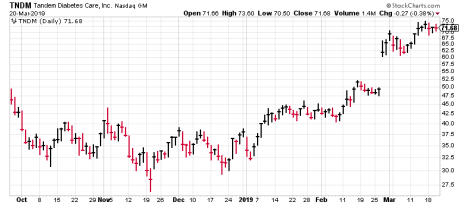I’ve been busy as all get-out this week, with some personal stuff to attend to, my normal writings, my webinar that I did on Wednesday and prep work for the NFL draft (just kidding … sort of). Thus, I’m going to make my Cabot Wealth Daily column this week a bit shorter and to the point.
Way back before I had grey hair in my beard, I actually minored in economics in college (major was finance), so despite my regular giggles at economists and their forecasts, I actually do keep a distant eye on some economic reports, especially those that tend to be leading indicators (jobless claims, housing permits, certain durable goods orders and new order indexes).
To be clear, I never trade based on these reports, but I like to have an idea of what’s going on and what the hubbub is among investors when it comes to the economy.
Recently, these reports have been mostly dreadful. Jobless claims, while still healthy, appear to have bottomed back in September of last year and are creeping up. Retail sales had their biggest one-month drop in years in December and barely rebounded in January. And just about everything housing-related has softened significantly. All told, current estimates for Q1 GDP growth are just north of zero!
[text_ad]
And none of this even touches what we’re seeing overseas (China’s economy slowing sharply and Europe arguably near recession territory) or from certain economically-sensitive companies—FedEx’s (FDX) horrid earnings guidance this week grabbed the headlines, for instance.
With the economy clearly decelerating, most investors see this as a bearish item, and I’m not just talking about individual investors. A recent Bank of America survey of 200 global institutional investors that manage hundreds of billions of dollars found that they are, relative to the past 20 years, extremely overweight cash and underweight equities. Hedge funds alone actually have their lowest allocation to equities since December 2016!
It makes sense—fading economic projections should eventually lead to fading earnings estimates, which in turn should lead to sour performance from stocks. But as with so many things, common sense doesn’t work in the stock market.
Why You Should Buy Stocks Now
As it turns out, though, the economy and the stock market are often out of gear for long stretches. Consider this: During the past 13 years, the two fastest growth years for U.S. GDP were 2015 (S&P 500 fell 1%, market was mired in a long, tedious bearish phase) and 2018 (S&P 500 fell 6.5% after the Q4 meltdown).
Meanwhile, many of the slowest economic growth years (1.8% GDP growth in 2013 led to a 30% gain in stocks; 2.2% growth in 2017 saw the S&P rise 19%) will often see the market do very well.
By the way, if you’re thinking, “We live in a global economy—profits are what counts, not just U.S. GDP growth,” consider that last year was one of the best years for profit growth (partially thanks to the corporate tax cuts), but that didn’t stop the market from losing ground. Heck, profits for the S&P 500 soared from 2000 to 2013 but the market itself made no net progress!
The reason the market can dance to its own drummer for months or years at a time is because stocks move on investor perception—and that perception can change based on various events, including the Federal Reserve, fiscal policy, wars, uncertainty and so on and so forth. Think of it this way: If forecasting the stock market was as easy as looking at the latest economic reports, economists would be managing huge mutual funds. But they’re not.
My point isn’t that the stock market and economy have no link at all—at least in the short term; over time, they obviously do. But the bigger thing to know is that using economic data or outlooks to gauge the market’s health doesn’t work. Said another way, the recent spate of poor economic reports shouldn’t be something you trade off of; instead, use the message of the market itself (and the stocks you own) to make those decisions.
One Bull Market Stock to Consider
So what is the market saying now? Mostly, it’s bullish, and for reasons I’ve laid out in my investment advisories, I think the bigger picture outlook remains very positive.
Shorter term, though, I tend to think the pullback that started in mid-February for many indexes and sectors is still going on. Yes, I realize the S&P 500 and Nasdaq recently hit new recovery highs, but the broad market has not (see the chart of the Russell 2000 below), and the number of stocks hitting new highs was meaningfully less during this latest upmove.
It’s not the end of the world, but my guess is that, short term, we’re going to see more tricky trading—pullbacks, sector rotations, potholes, etc. That means it’s probably a good idea to tighten stops on any laggards you own, and on the buy side, aim to enter on weakness.
One idea: Tandem Diabetes (TNDM), maker of the t:slim X2 insulin pump, which looks like the best mousetrap in a competitive but huge and growing field. The t:slim is around 30% smaller than most of the competition, has a touchscreen, is integrated with Dexcom’s continuous glucose monitoring system, can be updated remotely and comes with a predictive software that reduces the frequency and duration of low glucose events. (There was a snafu with that software recently, but a remote update that fixes it is on the way.) Beyond the t:slim, the entire industry is making great technological advances, which is enticing more diabetics to ditch multiple daily injections (often a dozen or more times per day) and go with pumps; Tandem estimates just 28% of Type 1 diabetics (its target market) in the U.S. currently use pumps, but that could grow to 50% over time. And given the size of the market—three million people in the U.S. (Type 1 and 2) are candidates for pump therapy, with another three million overseas in Tandem’s target markets (the firm just launched internationally last summer)—there’s huge potential for all players, especially leaders like Tandem.
After a big correction last year, the stock changed character earlier this year, then gapped to new highs after a fantastic Q4 report (revenues up 89%, and earnings of two cents a share, miles above estimates) and outlook. TNDM hit a higher high recently on increased volume, confirming that buyers are still active—any shakeout or pullback back into the mid- to upper-60s would be tempting, but just be sure to use a liberal loss limit as the stock is extremely volatile.
Despite the economic red flags, it’s a good time to buy stocks. And if you want more growth ideas like TNDM, simply click here to subscribe to my Cabot Growth Investor advisory.
[author_ad]




